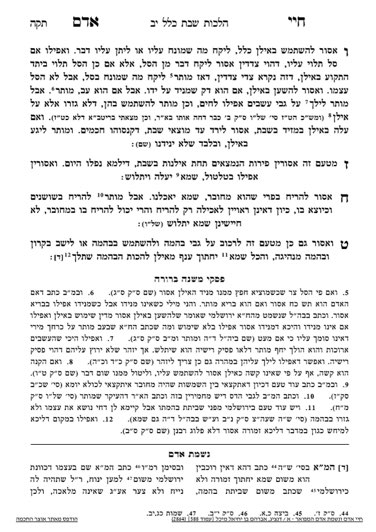Sponsorships for the upcoming Klalim, which discuss the 39 melachos of Shabbos, are available. Please contact Rabbi Reingold for more information at rabbireingold@gmail.com or 301.996.5910
We are continuing in siman 6, discussing the issur of using a tree on Shabbos. We learned that the Chayei Adam differentiates between using one’s hands and using one’s body to interface with the tree. The Chayei Adam writes that it is assur to lean on a tree on Shabbos, if the tree is thin enough that it will move when leaned on. However, if the tree is thick enough that it will not move, it is muttar to lean, since one would be using their body and not their hands.
The Chayei Adam continues, and writes that it is muttar to walk on grass on Shabbos, including fresh grass where there is a potential issue of kotzair (see shiur s352). The Mishnah Berurah writes that if one is moving quickly in tall grass, there is a good enough chance that the grass will get torn that it is a psik reisha that it will be torn. If so, it would be assur to move quickly through such a field. That being said, most situations where one is walking regularly are not a concern. Additionally, Chazal were not concerned that one should be allowed to make use of the grass (to walk on top of it), and did not make a gezeira against using it. The gezeira is only against making use of trees, as we have learned (0353).
Thus, if a person has a tree stump which is less than 3 tefachim high, the stump is batel to the ground and is no longer considered a tree. If more than 3 tefachim are left of the tree, sitting on the trunk is considered using the tree. However, assuming that the trunk is thick enough that it will not move when sitting on it, it would be muttar to sit, since any movement would be as a result of one’s body and not one’s hands.
If one went up the tree, and transgressed the issur of Chazal against climbing a tree, Chazal imposed a kenas that the person must remain in the tree until after Shabbos. The Chayei Adam uses the word kenas, that it is a fine. Others suggest that it is not a kenas in as much as the reality that in order to climb down, one will have to again use the tree. They explain that remaining stationary in the tree is much more passive than actively using the tree to climb down, so it is preferable to remain in the tree. There is no issur to touch the tree, since the tree is muktzah, and there is no issur to touch muktzah. The only issue is moving the tree, since moving muktzah is assur. Imperceptible movements are irrelevant in halacha, so they understand that it is preferable to remain in the tree rather than use the tree to get down.
Summary
A tree is assur to use on Shabbos. It is not assur to touch, but it is assur to move it. However, Chazal only established their issur when moving a tree with one’s hands, not with one’s body. Therefore, leaning against a tree or sitting on its stump is not a problem if the tree is thick enough it will not move.
If one climbed up the tree, they cannot climb down until after Shabbos.



